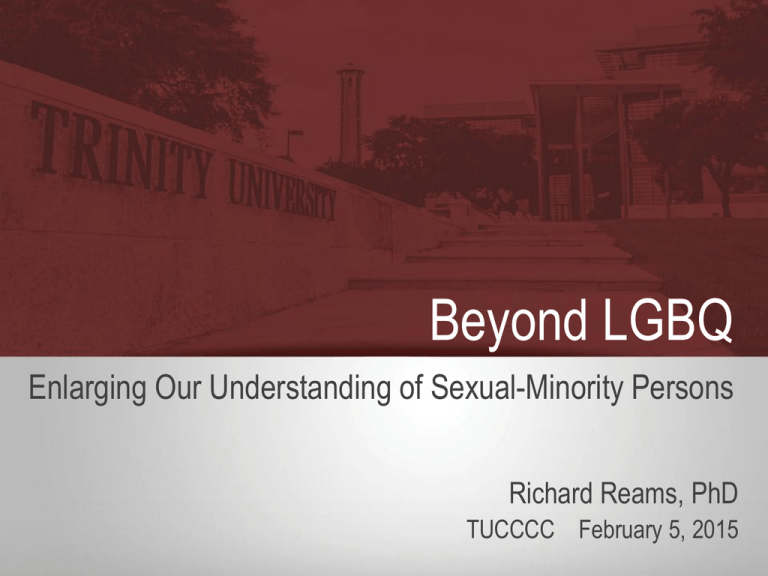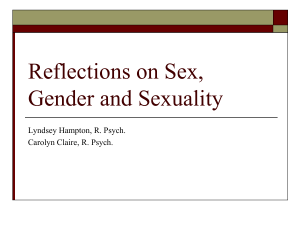
Beyond LGBQ
Enlarging Our Understanding of Sexual-Minority Persons
Richard Reams, PhD
TUCCCC February 5, 2015
A Bit about Me
With Trinity’s Counseling Services since 1994
Have taught an annual class “exploring the complexity
sexual orientation and identity” since 2004
Provide continuing 2-6 hour continuing education
workshops for pre-doctoral internship programs and
local psychological associations
Published website “‘Am I Gay?’ A Guide for People
Who Question their Sexual Orientation” last year
(www.YourSexualOrientation.info)
A Bit about You
How would you estimate your current cultural competence
to offer affirmative therapy to sexual-minority clients,
including those who self-identify as LGBQ?
Basic level
Intermediate level
Very basic knowledge, very limited clinical experience
More than basic knowledge, significant clinical experience
Advanced level
Extensive, up-to-date knowledge; extensive clinical experience
Who is a ‘Sexual-Minority’?
Sexual Minority refers to anyone who is not
exclusively heterosexual in identity,
attractions, or behaviors
By age 26, 10.7% of men and 24.5% of women
reported being attracted to their own sex at some
time (Dickson et al, 2003)
At any point in time, 5-7% of men and 12-20% of
women will report same-sex attractions (Diamond, 2014)
How Many Americans
Self-Identify as LGBQ?
About 3.5% are willing to acknowledge an
LGBQ identity on a survey or to an interviewer
(Gates 2012, Ward et al 2014)
Women are substantially more likely than men to
identify as bisexual
Current survey methods underestimate selfreports of an LGB identity by 65% (Coffman et al 2013)
7% of Trinity University students self-report
an LGBQ identity
Small Group Conversation #1
What have you discovered in
working with sexual-minority clients
that goes beyond or contradicts
what you were taught in graduate
school about working with LGBQ
clients?
Learning Objective #1
… you will be able to identify 3 developments
in our understanding of the diversity of
sexual-minority persons
I’m going to present 6 developments
How many others came out of the discussions?!
These developments are related to the
concepts of Sexual Orientation and Sexual
Orientation Identity.
Sexual Orientation
APA’s definition: “An enduring pattern of
emotional, romantic, and/or sexual attractions to
men, women, or both sexes.”
Sexual Orientation Identity
A [socially-recognized] label (e.g., gay, lesbian) for
one’s sexual orientation that may or may not
accurately reflect one’s sexual orientation or match
previous or ongoing sexual contact.
I. Sexual Orientation: Recent
Developments in Our Understanding
“An enduring pattern of emotional, romantic,
and/or sexual attractions to men, women, or
both sexes.”
1. Sexual attractions & romantic attractions
2. Asexuality
3. The (ir)relevance of gender
4. Sexual fluidity
1. The Relationship between Sexual Desire
& Romantic Love can be Complicated
“An enduring pattern of emotional, romantic,
and/or sexual attractions to men, women, or
both sexes.”
Many definitions of SO include only the sexual
dimension, e.g.
SO is “the trait that predisposes us to experience
sexual attraction to people of the same sex as
ourselves, to persons of the other sex, or to both.”
--Simon LeVay (2011), Gay, Straight and the Reason Why
1. The Relationship between Sexual Desire
& Romantic Love can be Complicated
Lisa Diamond (2003), What does sexual orientation orient: A biobehavioral model
distinguishing romantic love from sexual desire? Psychological Review, 110, 173-192
Sexual Desire and Romantic Love are
functionally independent
SD evolved for sexual mating reproduction
RL evolved for pair-bonding infant survival
Probably genetically-driven to some extent
Probably biologically-mediated via oxytocin
Thus, there is no biological requirement that
romantic love and sexual desire be congruent
1. The Relationship between Sexual Desire
& Romantic Love can be Complicated
Implications of the independence of SD & RL
Romantic love can exist without sexual desire
Heterosexuals can experience same-sex infatuation
(and vice versa)
Time, togetherness, and touch facilitate romantic
love without sexual desire
A person can have a romantic orientation toward
people of one sex and a sexual orientation toward
people of another sex
2. Asexuality is Becoming Visible
“An enduring pattern of emotional, romantic,
and/or sexual attractions to men, women, or
both sexes.”
Asexual Visibility and
Education Network
(www.aven.org)
Anthony Bogaert (2012),
Understanding Asexuality
2. Asexuality has Become More Visible
Asexuality is the absence of sexual attraction
and desire to engage in sexual behavior with
another person
About 1% of adults
Asexuality does not imply the absence of
romantic attractions and desire to share an
intimate romantic relationship with another
person
2. Asexuality has Become More Visible
“Asexuals who are in relationships and have
romantic attachments to their partners are an
important test case of the theory that sexual
and romantic attraction can potentially operate
independently.” (Bogaert, 2012, p. 8)
AVEN’s proposed “Asexual Spectrum”
(handout)
2. Asexuality has Become More Visible
Asexuality generates some questions:
Should we — or will we eventually — shift to
two concepts: Sexual orientation and
Romantic orientation? And develop identify
labels that reflect both?
Is asexuality a SO? “An enduring pattern of
emotional, romantic, and/or sexual attractions
to men, women, both sexes, or neither sex.”
3. Gender is Irrelevant to Some People’s
Attractions
“An enduring pattern of emotional, romantic,
and/or sexual attractions to men, women, or
both sexes.”
The very concept of SO is based on two genderrelated assumptions
Attraction is “to men, women, or both sexes”
Each person’s gender identity fits within
“the gender binary” of male and female
3. Gender is Irrelevant to Some People’s
Attractions
Some people are
“attracted to the person,
not the gender”
Lisa Diamond (2008)
Sexual Fluidity
3. Gender is Irrelevant to Some People’s
Attractions
When most people find another person to be
desirable, they are responding to a mix of
gender-based and gender-neutral traits
Gender-based traits include gender-specific
physical attributes (e.g., women’s breasts, men’s
chest hair)
Gender neutral traits include sense of humor,
self-confidence, playfulness, passion, intelligence
3. Gender is Irrelevant to Some People’s
Attractions
For some people, perhaps more commonly
among women than men, gender-based traits are
largely or totally irrelevant
Some people “respond erotically to anyone with
a desirable personality or with whom they have a
strong connection, regardless of that person’s
gender.” These individuals often describe
themselves as being “attracted to the person, not
the gender.” (Diamond, 2008)
3. Gender is Irrelevant to Some People’s
Attractions
How might we rethink sexual orientation in
light of person-based [nonexclusive]
attractions? Diamond offers two possibilities.
“The capacity for person-based attractions
might actually be an independent form of
sexual orientation” . . . “a fourth category
of individuals for whom gender is irrelevant.”
(p.186)
3. Gender is Irrelevant to Some People’s
Attractions
“Another possibility is that a capacity for
person-based attractions is . . . an
independent characteristic that all
individuals possess, in greater or lesser
degrees. To consider how this might work,
consider sex drive as an analogy.” (p.188)
4. Sexual Orientation can be Fluid
“An enduring pattern of emotional,
romantic, and/or sexual attractions to men,
women, or both sexes.”
Although the pattern is stable (enduring) for
many people, it is not for many other people
4. Sexual Orientation can be Fluid
General patterns of attractions can narrow or
widen
Gradual narrowing of attractions: Many youth
who ultimately come out as gay experienced both
opposite-sex and same-sex attractions during
childhood and adolescence. As time passed, the
opposite-sex attractions faded or disappeared, and
the same-sex attractions emerged as dominant or
exclusive.
4. Sexual Orientation can be Fluid
Gradual widening of attractions: Some adults
who have historically experienced only same-sex
attractions or other-sex attractions find themselves
having one or more experiences that expands their
sexuality as they grow older, e.g.,
A lesbian who falls in love with a man to the
dismay and even anger of her lesbian friends
A heterosexual woman who falls in love with a
female friend
Other developments in our understanding of
sexual orientation?
II. Sexual Orientation Identities:
Expanding Options
Sexual Orientation Identity: A [sociallyrecognized] label (e.g., gay, lesbian) for one’s
sexual orientation that may or may not
accurately reflect one’s sexual orientation or
match previous or ongoing sexual contact.
The models of sexual orientation identity
development assumed that identity development
among gays and lesbians would lead to a stable,
positive self-identification
5. The Increasing Rejection of Sexual
Orientation Identity Labels
A major assertion of
Ritch Savin-Williams
in his book The New Gay
Teenager (2005)
5. Rejecting Sexual Orientation Identity
Labels among Some Sexual-Minority Youth
Ritch probably overstates the trend
Nonetheless, some youth do reject employing
a label because
No label describes their complex sexual orientation
Labels can evoke stereotypes
A SO label can obscure the multidimensionality of the
individual in the eyes of others
SO is not a major component of the person’s identity
6. New Identity Labels are Emerging
Some trends among those sexual-minority people
who are willing to label their sexual orientation
‘Pansexual’ and ‘Fluid’ are becoming
preferred to ‘bisexual’
Pansexuality: Sexual attraction, sexual desire, romantic love, or emotional
attraction toward people of any sex or gender identity (Wikipedia)
‘Bisexual’ has undesirable connotations
That the person is equally attracted to men and women
That the person exemplifies the negative stereotypes
6. New Identity Labels are Emerging
Identity labels that may emerge:
(Thanks to the Internet, new labels can take root)
‘Mostly Straight’
Recent discovery that more people will choose this label
when it is offered than all other hon-heterosexual labels
combined (i.e., bisexual, mostly gay, and gay)
‘Biromantic Heterosexual’ etc. by combining
romantic orientation and sexual orientation
labels
Other developments in the evolution of sexual
orientation identities?
Small Group Conversation #2
(Re: Learning Objective #2)
What challenges might you encounter
working affirmatively with clients
whose experience of their sexual
orientation or identity differs from your
assumptions or personal experience?









